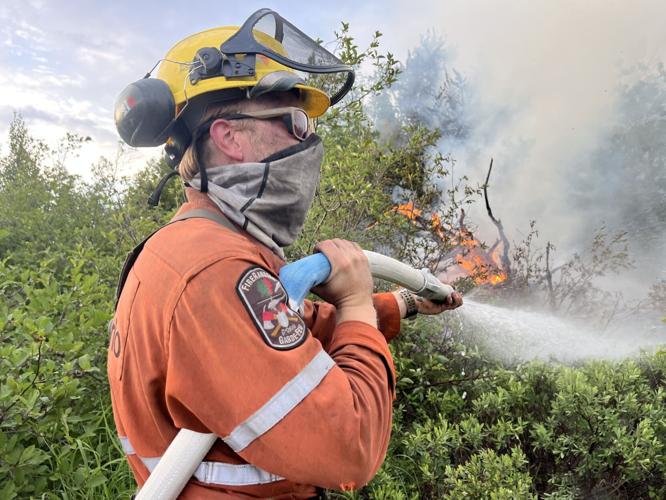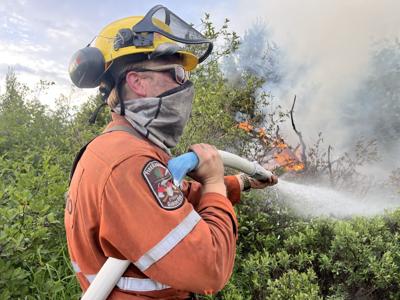The grey scarf is made from the same flame-retardant material as their uniforms, but it’s not doing much to protect their lungs.
The BarriAire neck gaiters issued to Ontario forest firefighters this summer to filter out carcinogenic smoke aren’t certified for workplace use, will not protect wearers from particulates, gases and vapours and are “not acceptable as a stand-alone control to reduce exposure,” according to an internal Ministry of Natural Resources (MNR) document.
Nevertheless, the MNR recommends that Ontario fire rangers “wear one as much as possible, when conditions allow, during suppression of active fires, mop-up, or while at staging areas, line camp, and base camp,” according to a March 2025 safety training bulletin, obtained by the Star.
Last year, front-line wildland firefighters won a long battle to get presumptive illness coverage at the Workplace Safety and Insurance Board, recognizing that chronic exposure to wildfire smoke can lead to a lengthy list of cancers or cardiovascular disease. While this means veteran firefighters can get compensation for previous exposure to toxic substances, it also left the provincial government scrambling to protect the fire rangers on the job today.

An Ontario fire ranger wears a “buff” issued by the Ministry of Natural Resources for the first time in 2025 to provide protection against toxic particles in smoke.┬á
MARCO CHOWN OVED / TORONTO STARTheir solution: buffs.
The safety bulletin says the MNR is still studying exposure levels and appropriate protection and brought in the buffs as an interim measure on a ÔÇťnonmandatory, opt-in basis.ÔÇŁ
But introducing new personal protective equipment (PPE) has cleaved a culture clash between veterans, many of whom don’t consider forest fire smoke to be dangerous, and a new generation of wildfire fighters who are more likely to want respiratory protection.
Both groups appear to agree on one thing: like cotton masks during COVID, the buffs are totally ineffective.
“Nobody wears them other than the odd rookie,” said Noah Freedman, a crew leader with 10 seasons experience fighting wildfires. “You don’t have to be a PhD to understand they don’t do anything.”
They don’t have a good seal, they get dirty “instantaneously” and they’re hot, making it hard to breathe, said Freedman, who is also vice-president of the wildland firefighterÔÇÖs union, OPSEU Local 703.
Meanwhile, a rookie fire ranger working in northwestern Ontario says half his crew members wear one but no crew bosses or supervisors do.
ÔÇťPeople donÔÇÖt take it very seriously,ÔÇŁ said the fire ranger, whom the Star agreed not to name because they arenÔÇÖt permitted to speak with the media. ÔÇťThey say the safety briefings are just propaganda. Smoke is par for the course. ItÔÇÖs what you sign up for.ÔÇŁ
ÔÇťOf course, I donÔÇÖt agree,ÔÇŁ they added. ÔÇťWhen IÔÇÖm on the fire line, if IÔÇÖm not wearing it, I can feel it in my lungs. My nose gets stuffy.
ÔÇťI highly doubt they are filtering out the worst stuff,ÔÇŁ said the fire ranger. ÔÇťBut somethingÔÇÖs better than nothing.ÔÇŁ
In response to questions about the buff, Maria Votsis, spokesperson for Natural Resources Minister Mike Harris Jr. sent a statement saying the introduction of the buffs this year was not liked to the newly-won cancer coverage for firefighters.
“The narrative suggested in your questions ÔÇŽ that the sole motivation behind the addition of masks to FireRangerÔÇÖs PPE is┬ábecause they now have WSIB presumptive coverage for several cancers, linked to smoke exposure, is an irresponsible narrative and blatantly untrue,” she wrote.
“We are proud to be recognized as leaders in wildland firefighting safety, ensuring FireRanger teams are equipped with specialized equipment to keep them safe on the job,” she wrote, adding that the buffs “provide a measure of respiratory protection in the field.”┬á
Wildfire fighting presents unique challenges for determining the best way to protect workers, said Sandra Dorman, a professor in the Faculty of Health at Laurentian University and the director of the Centre for Research in Occupational Safety and Health.
Dorman, who has been studying forest firefighter health and safety at the Aviation, Forest Fire and Emergency Services branch of the MNR since 2007, says you canÔÇÖt just issue the same oxygen tank and full-mask respirator that municipal fire departments use.
Marco Chown Oved got certified as a wildland firefighter to understand OntarioÔÇÖs growing wildfire crisis and what it takes to be prepared for the frontlines.Marco Chown Oved got certified as a wildland firefighter to understand OntarioÔÇÖs growing wildfire crisis and what it takes to be prepared for the frontlines.
Fire rangers spend entire days on the fire line and would quickly run out of oxygen. The extra weight would encumber the small helicopters that ferry people and equipment in and out of fires. The mask, some argue, would provide a false sense of security and get fire rangers into dangerous situations they never would have been in if they were breathing without assistance.
But perhaps worst of all, the respirators would exacerbate the already intense heat fire rangers encounter, increasing the likelihood of heat stroke, trading one health hazard for another.
ÔÇťItÔÇÖs another layer of heat entrapment,ÔÇŁ she said. ÔÇťI donÔÇÖt think anyone questions anymore the health effects of smoke. But this is a complex problem to solve.ÔÇŁ
Unlike B.C. wildfire fighters, who leave the fire overnight, OntarioÔÇÖs fire rangers camp for up to two weeks at remote fires, because there is no way in or out except by helicopter. This means fire fighters in B.C. get recovery time away from smoke, she said, while in Ontario, theyÔÇÖre exposed 24 hours a day, which affects their bodiesÔÇÖ ability to bounce back.
This season, Dorman is gathering data from air quality monitors that will be carried by fire rangers, positioned on the fire line and in base camp to help the MNR determine the best way to mitigate the effects of smoke.
ÔÇťHow can we reduce exposure?” she asked. “What can we do at night in the tent to help recovery?ÔÇŁ
Previous studies Dorman carried out on Ontario wildland firefighters found they had increased inflammation in their airways due to smoke exposure and their lung volume was reduced at the end of a season.
ÔÇťThey’re absolutely getting exposed to too much,ÔÇŁ she said. ÔÇťThe question is how can we gather information to better protect them in the future?ÔÇŁ
A climate change expert says Canada isn't doing enough to prevent tragedies similar to the flash flooding that hit Texas, where the death toll has surpassed 100. Ryan Ness of the Canadian Climate Institute says climate change is making flash flooding worse, and the country needs to invest in flood mapping, infrastructure and early warning systems.
(July 8, 2025)B.C. started issuing buffs with the rationale that anything is better than nothing, Dorman said.
Until Ontario is able to determine exactly what the levels of exposure are, and where respite might be found, the buffs act as a placeholder that indicates to fire rangers that more change is coming.
ÔÇťIÔÇÖm not going to defend the buff. But IÔÇÖm also not going to throw it in the garbage can,ÔÇŁ she said.

































To join the conversation set a first and last name in your user profile.
Sign in or register for free to join the Conversation